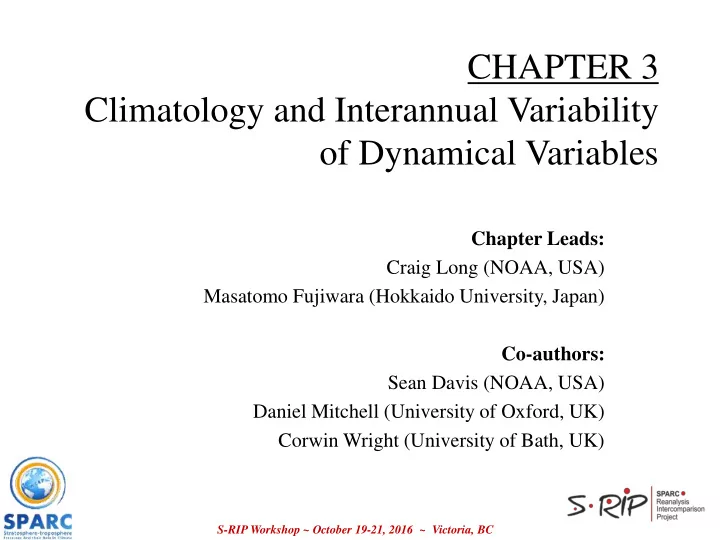

CHAPTER 3 Climatology and Interannual Variability of Dynamical Variables Chapter Leads: Craig Long (NOAA, USA) Masatomo Fujiwara (Hokkaido University, Japan) Co-authors: Sean Davis (NOAA, USA) Daniel Mitchell (University of Oxford, UK) Corwin Wright (University of Bath, UK) S-RIP Workshop ~ October 19-21, 2016 ~ Victoria, BC
Table of Contents • SUMMARY 2 • 3.1. INTRODUCTION 3 • 3.2. REANALYSES GLOBAL TEMPERATURE ANOMALY VARIABILITY WITH TIME 5 • 3.3. REANALYSIS ENSEMBLE MEAN (REM) 6 • 3.3.1. Methodology 6 • 3.3.2. Climatology of the REM 6 • 3.3.3. Agreement Among the REM Members 9 • 3.4. INTERCOMPARISONS OF THE REANALYSES 12 • 3.4.1. Temperature 12 • 3.4.2. Zonal wind 14 • 3.5. AMPLITUDE OF POLAR ANNUAL TEMPERATURE CYCLE 17 • 3.6. COMPARISONS WITH INDEPENDENT OBSERVATIONS 17 • 3.6.1. MLS and HIRDLS Temperatures 17 • 3.6.2. Atmospheric Layer Temperature Anomalies 17 • 3.6.3. Ozonesonde Temperatures 18 • 3.6.4. Long-duration Balloon Observationss 20 • 3.6.5. Rocketsonde Observations 21 • 3.7. EFFECTS OF VOLCANIC ERUPTIONS ON REANALYSIS TEMPERATURES AND WINDS 25 • 3.8. SUMMARY AND CONCLUSIONS 23 • REFERENCES 29 • Appendix A. LIST OF ACRONYMS 27 •
Schedule • Under internal review now • External review soon after • Paper?
Key Findings • TOVS vs ATOVS periods have different temp and wind characteristics in middle and upper stratosphere. • CFSR has a warm bias and JRA-55 has cold bias in upper stratosphere compared to MERRA and ERA-I. • Comparisons with MLS and HIRDLS temperatures produce similar bais results. • CFSR stream jumps interfere with any trend analysis and introduces too much noise to the REM. • ERA-I has smaller annual temperature cycle in SH polar latitudes during the TOVS period above 10 hPa. • All reanalyses QBO winds correlate well with Singapore winds, but are weaker – Improvement in ATOVS period • CFSR, MERRA, ERA-I, JRA-55 replicate NOAA TLS CDR well • MERRA, ERA-I, JRA-55 replicate NOAA SSU1&2 CDR well – Beginning years and ending years differ from CDR
Selection of Chapter Figures • Inclusion of MERRA-2 comparisons • QBO comparisons • Added HIRDLS Temp comparisons • Layer mean comparisons with NOAA SSU+AMSU CDRs
Global Temperature Anomaly
Global Temperature Anomaly
REM = MERRA & ERA-I & JRA-55
Temperature Variance of 3 Members 60N-90N 10S-10N 60S-90S
U Wind Variance of 3 Members 60N-90N 10S-10N 60S-90S m/s
60S-90S Temperature Diff from REM a) b) c) d) e)
60S-90S Temperature Diff from REM f) g) h)
60N-90N Temperature Diff from REM
60N-90N Temperature Diff from REM
Equatorial U Wind Diff from REM m/s
Equatorial U Wind Diff from REM m/s
REM U Wind Anomalies at Equator Figure 21. Reanalysis Ensemble Mean (REM) zonal wind departures (m/s) from the long term REM mean for each month between 10 ° S and 10 ° N. The REM is the average of MERRA, ERA-I, and JRA55 zonal winds.
Comparisons of REM with Singapore U winds Correlation Slope REM winds are weaker than Singapore Reanalysis U Wind Singapore U Wind
Comparisons of Reanalyses with Singapore U winds Correlation Slope 1980-2014 1980-1998 1999-2014
SH Max T Month – Min T Month
NH Max T Month – MinT Month
MLS Comparisons : 60N-80N 2004-2014
MLS Comparisons : 60N-80N 2004-2014
HIRDLS Comparisons : 60N-80N 2005-2008
SSU & MSU 1978-2005 AMSU-A 1998-Present 3 SSU 2 1 4 9 MSU
TLS - Lower Stratosphere MERRA & MERRA-2 CFSR JRA-55 ERA-I Clim = 1981-2010
SSU 1 – Middle Stratosphere MERRA & MERRA-2 CFSR JRA-55 ERA-I
SSU 2 - Upper Stratosphere MERRA & MERRA-2 CFSR JRA-55 ERA-I
Any Comments or Suggestions? Did I miss anything?
Recommend
More recommend